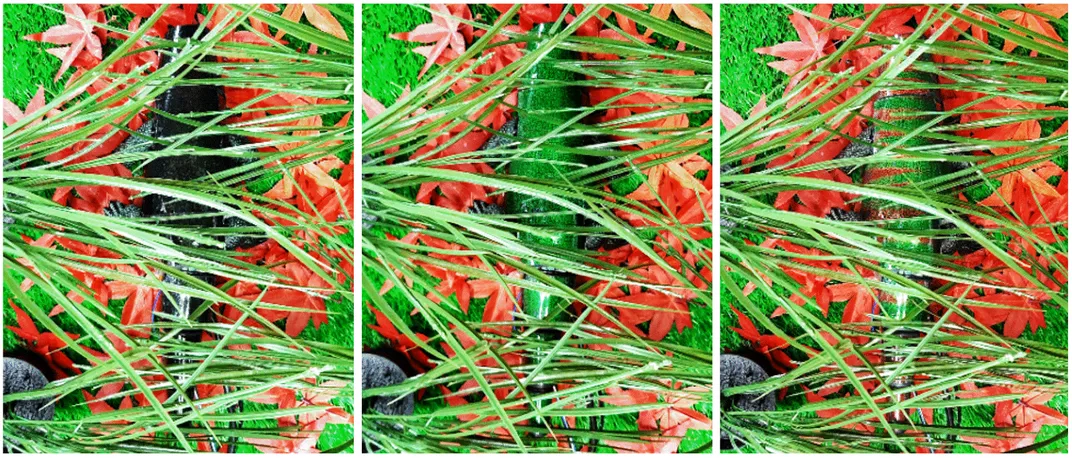Scientists Design a Robotic Chameleon That Crawls and Changes Color
A new artificial skin can sense its surroundings and create a camouflage coat
/https://tf-cmsv2-smithsonianmag-media.s3.amazonaws.com/filer/d2/9a/d29a0cdb-1290-4835-a592-2974adc7e277/gettyimages-167541008-resized.jpg)
A team of Korean researchers was so fascinated by chameleons that they made a robotic one, complete with googly eyes, a waddle-style gait and most importantly, a skin that changes color on demand.
“It's walking around and also changing color at the same time,” says study author Seung Hwan Ko, a mechanical engineer at Seoul National University in South Korea. “So it's kind of like a full working chameleon.”
The artificial electronic skin adjusts its hues instantly and automatically to match the background colors the robot crawls over. The invention, detailed today in the journal Nature Communications, is one of the first devices to change color and patterns based on its environment. It could also help scientists craft a new generation of active camouflage wear for military applications or help designers create fashion styles that flash different colors depending on nearby backgrounds.
In addition to different colors, the robot can display several preprogrammed patterns on its exterior. The skin doesn’t exactly mirror a nearby background, but even real-life chameleons shift their shades not to reflect their surroundings, but to blend in. To copy this capability, the researchers give the skin several patterns to choose from, each which can flash on or off independently. The combination of these pre-patterned dots, stripes and curlicues capture the complexity of most backgrounds for the robot to execute its great disappearing act.
“It is not necessary to match the background perfectly,” says study author Sukjoon Hong, a mechanical engineer at Hanyang University, “because as [long] as it is complex enough, then we can get sufficient amount of [camouflage].”
To construct the robot’s coat of many colors, the researchers made a “skin” using a thin glaze of liquid crystal ink that can take on any color, depending on the alignment of its molecules. When these particles assemble into larger helical structures, they can reflect a specific color of light. The size of the structures dictates the color displayed. A larger repeating arrangement gives reddish tints. Tighter arrangements appear blue.
The liquid crystals change their orientation—and their color—based on temperature. So, the researchers stacked prepatterned heater strips under the fake lizard’s skin. Up to ten color sensors sit on the underbelly of the robot to take stock of the hues beneath the robot’s feet. The sensors relay the color information back to the robot’s control unit, which cranks up the heaters to best match the colors and markings on the floor. A device tucked inside the robot keeps the heating temperature in check to hold the colors steady.
The resulting robot can color-match its environment within half a second as it tromps along the floor. The researchers demonstrated that the robot can hide effectively against a backdrop of leaves and flowers; it gives off tiger-like stripes by activating several heater patterns at once.

Temperature-sensitive liquid crystals aren’t new, but the simplicity of how the researchers use them to create a chameleon effect is impressive, says Chengyi Xu, a materials engineer at Stanford who wasn’t involved in the study. He adds that previous studies usually showcased color-switching technologies only in small devices controlled by humans. Instead, Hong and Ko’s team fully decked their chameleon model in a coat that alters color on its own. Xu says the researchers do a good job of integrating several technologies, such as the color detection and temperature controls, to attain the most lifelike chameleon robot yet. “This is more towards the future of autonomous color-changing devices,” says Xu.
The thermal control of the liquid crystal coat has several limitations, says Steven Morin, a chemist at the University of Nebraska–Lincoln. First, he says the skin is easier to heat than to cool down, so it may not switch from a hot color like blue to a cold color like red as fast as it would switch from red to blue. Furthermore, the temperature ranges the robot uses are rather narrow, from room temperature of 78 degrees Fahrenheit to approximately human body temperatures of 97 degrees. And Morin says that the skin color may be affected by its surroundings, especially in chilly weather or under direct sunlight on a hot day.
Morin admits that replicating color shifting in robots is tricky. Nature makes it look so easy, but the response time and the arbitrariness of patterns in chameleon skin are hard to replicate.
Cognizant of the weaknesses Morin points out, Ko and Hong’s team already have several solutions in the works. For example, they say adding in a cooling system may widen the temperature range and hasten the robot’s reflexes.
In the future, the researchers aim to build another color changing icon in the animal kingdom with a squirming chassis to match: an octopus. They’ll borrow the design of the artificial chameleon skin to achieve camouflage in their cephalopod. But “it's movement is much more complex than a chameleon,” says Ko, which is where the main engineering challenge lies.
Like the researchers, both Xu and Morin have also worked on bioinspired color-changing materials in the past, using divergent approaches to imitate what the live animals still do best. Researchers in the field are still long ways off, says Xu, and he’s constantly in awe of the physiologies of these actively camouflaging creatures.
“Everything is just so sophisticated,” he says.
Editors' Note, August 11, 2021: This article originally misstated the school Sukjoon Hong works at. It is Hanyang University.
/https://tf-cmsv2-smithsonianmag-media.s3.amazonaws.com/accounts/headshot/kim.png)


/https://tf-cmsv2-smithsonianmag-media.s3.amazonaws.com/accounts/headshot/kim.png)